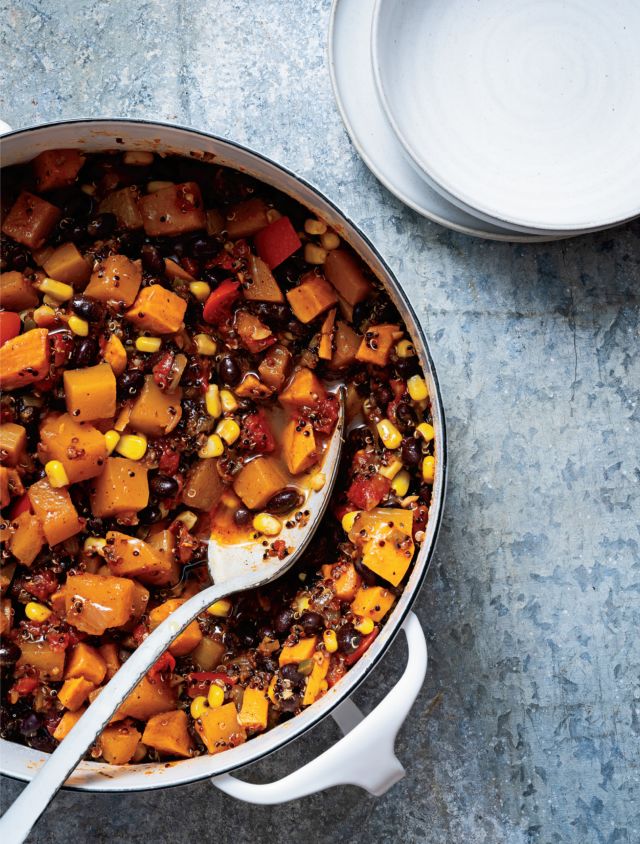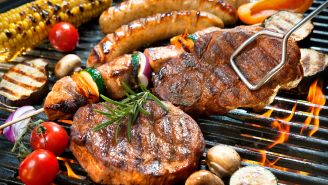The timing and choices of your meals matter to your overall health, according to Michael F. Roizen, MD, Michael Crupain, MD, MPH, and Jim Perko, Sr., CEC, AAC, authors of The What To Eat When Cookbook. This one-pot meal is perfect for a colorful lunch or light dinner. Plus, leftovers taste great up to two days. This is a great alternative to fast food lunches. The red, white, and black quinoa also provide all essential amino acids needed for building and maintaining muscles.
Prep: 35 minutes
Cook: 38 minutes
Makes: 6 servings
Serving size: 1 1/2 cups
Ingredients
2 tablespoons extra-virgin olive oil
1 1/2 cups onion, finely chopped
3 garlic cloves, minced
2 teaspoons tomato paste
2 cups vegetable broth
3 teaspoons chili powder
2 teaspoons ground cumin
1/2 teaspoon smoked paprika
1/2 teaspoon dried oregano
3/4 teaspoon kosher salt
1/4 teaspoon freshly ground black pepper
2 teaspoons jalapeño chili*, peeled, seeded, minced
2 cups (11 to 12 ounces) butternut squash, peeled, seeded, cut into 1/2-inch dice
1 cup (about 6 ounces) sweet potato (yam), peeled, cut into 1/2-inch dice
1 cup red bell pepper, cut into 1/2-inch dice
1 cup canned diced tomatoes in juice
1 can (15-ounce) black beans, drained and rinsed
1 cup frozen corn
1 cup quinoa (preferably mixed red, black, and white), rinsed in cold water
Directions
1. In a large pot, heat the olive oil over medium heat. Add the onion and sauté until lightly caramelized, about 10 minutes.
2. Add the garlic and sauté until aromatic, 1 to 2 minutes. Add the tomato paste and stir 1 minute. Add the vegetable broth and stir with a wooden spoon to deglaze the bottom of the pot. Add all of the spices, stir 30 seconds, then add the remaining ingredients and stir to combine. Bring to a boil. Reduce to medium-low heat; cover until the quinoa is cooked through and the vegetables are tender, about 25 minutes. Turn off the heat and let stand, covered, for 20 minutes for flavors to blend.
What to swap when
Create your own plant-forward variations by adding or substituting in other vegetables or different beans. You can also use different grains like brown rice, millet or farro.
*Note on chili preparation: It is best to wear vinyl or synthetic gloves, or wash hands frequently while handling chili peppers. Using a skewer and a low flame, hold the jalapeño pepper over the flame, roasting each side until a blistered skin forms. Once fully roasted and blistered, turn off flame, remove jalapeño from skewer, and wrap it in plastic for a few minutes, allowing the chili to “sweat” and cool. Remove plastic wrap, and using a small paring knife, gently scrape off all the blistered and blackened skin without rinsing (to preserve roasted pepper juice/flavor). Remove the seeds from the jalapeño and finely mince. You can prepare a bag of 6 or more jalapeños this way and freezing them in tablespoon increments for up to 2 months.
Calories: 293 kcal; Total fiber: 8.7 g; Soluble fiber: 0 g; Protein: 9.5 g; Total fat: 7.1 g; Saturated fat: 0.7 g; Healthy fats: 4.1 g; Carbohydrates: 51.7 g; Sugars: 8 g; Added sugars: 0 g; Sodium: 524 mg; Potassium: 614 mg; Magnesium: 30 mg; Calcium: 88 mg
Excerpted from The What to Eat When Cookbook, by Michael F. Roizen, MD, Michael Crupain, MD, MPH, and Jim Perko, Sr., CDC, AAC. Copyright © 2020 by Michael F. Roizen, MD. Reprinted by permission from National Geographic. Photo credit: Scott Suchman






